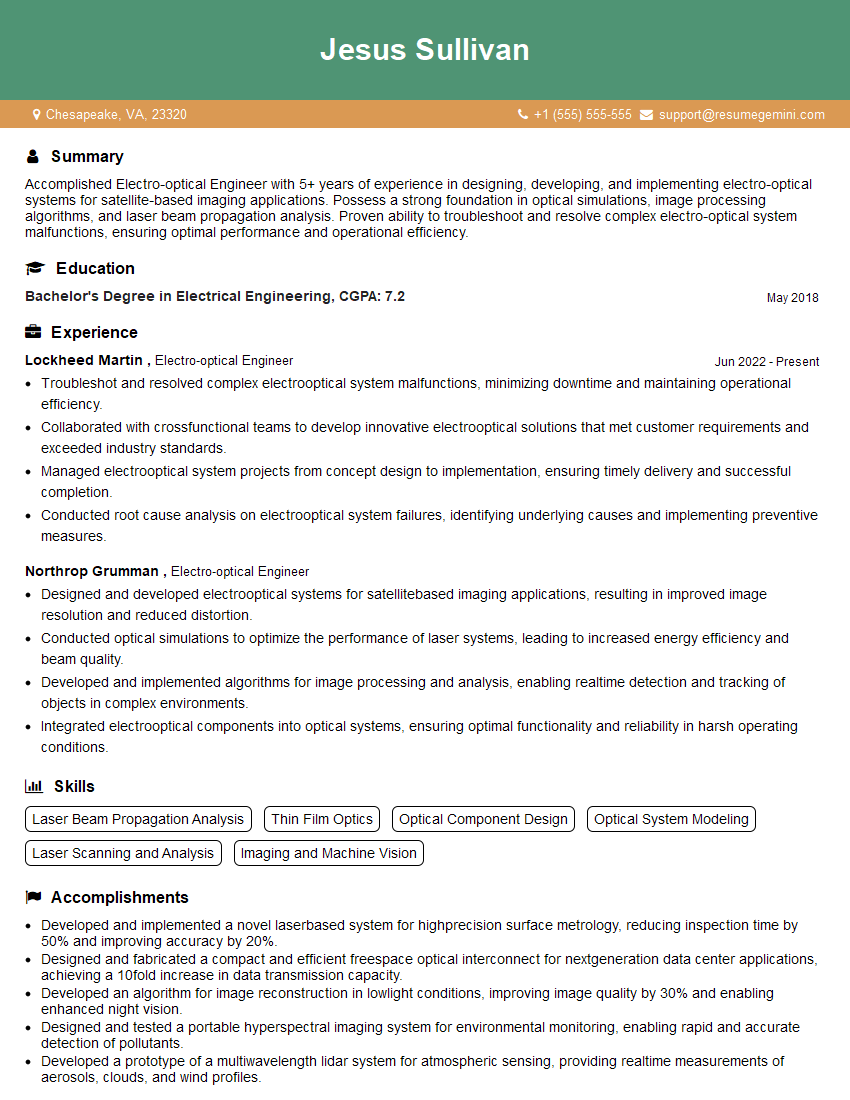Feeling lost in a sea of interview questions? Landed that dream interview for Electro-optical Engineer but worried you might not have the answers? You’re not alone! This blog is your guide for interview success. We’ll break down the most common Electro-optical Engineer interview questions, providing insightful answers and tips to leave a lasting impression. Plus, we’ll delve into the key responsibilities of this exciting role, so you can walk into your interview feeling confident and prepared.
Acing the interview is crucial, but landing one requires a compelling resume that gets you noticed. Crafting a professional document that highlights your skills and experience is the first step toward interview success. ResumeGemini can help you build a standout resume that gets you called in for that dream job.
Essential Interview Questions For Electro-optical Engineer
1. Explain the role of a photodetector in an electro-optical system?
A photodetector is a device that converts light into an electrical signal. In an electro-optical system, photodetectors are used to detect the presence, intensity, and wavelength of light. They are used in a wide variety of applications, including optical communications, imaging, and sensing.
2. Describe the different types of photodetectors and their applications?
Types of Photodetectors
- Photodiodes: Photodiodes are semiconductor devices that convert light into an electrical current. They are used in a wide variety of applications, including optical communications, imaging, and sensing.
- Phototransistors: Phototransistors are semiconductor devices that convert light into an electrical current. They are used in a wide variety of applications, including optical communications, imaging, and sensing.
- Photomultipliers: Photomultipliers are vacuum tubes that convert light into an electrical current. They are used in a wide variety of applications, including optical communications, imaging, and sensing.
Applications of Photodetectors
- Optical communications: Photodetectors are used in optical communications to convert light into an electrical signal. This signal is then used to transmit data over optical fibers.
- Imaging: Photodetectors are used in imaging to convert light into an electrical signal. This signal is then used to create an image.
- Sensing: Photodetectors are used in sensing to detect the presence, intensity, and wavelength of light. This information can be used to control a variety of devices, including security systems, lighting systems, and medical devices.
3. Discuss the factors that affect the performance of a photodetector?
- Responsivity: Responsivity is a measure of the amount of electrical current that a photodetector produces for a given amount of light. Responsivity is affected by a number of factors, including the wavelength of light, the intensity of light, and the temperature of the photodetector.
- Quantum efficiency: Quantum efficiency is a measure of the number of electrons that a photodetector produces for a given number of photons. Quantum efficiency is affected by a number of factors, including the wavelength of light, the intensity of light, and the temperature of the photodetector.
- Noise: Noise is a random fluctuation in the electrical signal produced by a photodetector. Noise is affected by a number of factors, including the temperature of the photodetector and the amount of light incident on the photodetector.
4. How can you improve the performance of a photodetector?
- Increase the responsivity: Responsivity can be increased by using a photodetector with a larger active area, a higher quantum efficiency, or a lower noise level.
- Increase the quantum efficiency: Quantum efficiency can be increased by using a photodetector with a higher absorption coefficient, a lower reflectance, or a lower noise level.
- Reduce the noise: Noise can be reduced by using a photodetector with a lower dark current, a lower temperature, or a lower noise figure.
5. What are the different types of optical modulators and how do they work?
- Electro-optic modulators: Electro-optic modulators use an electric field to change the refractive index of a material. This change in refractive index can be used to modulate the phase, polarization, or intensity of light.
- Magneto-optic modulators: Magneto-optic modulators use a magnetic field to change the refractive index of a material. This change in refractive index can be used to modulate the phase, polarization, or intensity of light.
- Acousto-optic modulators: Acousto-optic modulators use sound waves to change the refractive index of a material. This change in refractive index can be used to modulate the phase, polarization, or intensity of light.
6. What are the advantages and disadvantages of different types of optical modulators?
- Electro-optic modulators: Advantages: High modulation speed, low insertion loss, low power consumption. Disadvantages: High cost, limited wavelength range.
- Magneto-optic modulators: Advantages: High modulation speed, low insertion loss, low power consumption. Disadvantages: High cost, limited wavelength range.
- Acousto-optic modulators: Advantages: Wide wavelength range, low cost. Disadvantages: Low modulation speed, high insertion loss, high power consumption.
7. What are the different applications of optical modulators?
- Optical communications: Optical modulators are used in optical communications to modulate the phase, polarization, or intensity of light. This modulated light is then used to transmit data over optical fibers.
- Imaging: Optical modulators are used in imaging to modulate the phase, polarization, or intensity of light. This modulated light is then used to create an image.
- Sensing: Optical modulators are used in sensing to modulate the phase, polarization, or intensity of light. This modulated light is then used to detect the presence, intensity, and wavelength of light.
8. What are the challenges in designing and fabricating optical modulators?
- Reducing insertion loss: Insertion loss is a measure of the amount of light that is lost when a modulator is inserted into an optical system. Reducing insertion loss is important for increasing the efficiency of optical modulators.
- Increasing modulation speed: Modulation speed is a measure of how quickly a modulator can change the phase, polarization, or intensity of light. Increasing modulation speed is important for increasing the bandwidth of optical modulators.
- Reducing cost: Optical modulators are often expensive to design and fabricate. Reducing cost is important for making optical modulators more accessible.
9. What are the trends in the development of optical modulators?
- Miniaturization: Optical modulators are becoming smaller and more compact. This is important for making optical modulators more portable and easier to integrate into optical systems.
- Integration: Optical modulators are being integrated with other optical components, such as lasers and photodetectors. This is important for reducing the cost and complexity of optical systems.
- New materials: New materials are being developed for optical modulators. These new materials offer improved performance in terms of modulation speed, insertion loss, and cost.
10. What are the applications of electro-optical systems in the field of medicine?
- Imaging: Electro-optical systems are used in medical imaging to create images of the inside of the body. These images can be used to diagnose and treat a variety of medical conditions.
- Surgery: Electro-optical systems are used in surgery to guide surgeons during procedures. This can help to improve the accuracy and safety of surgery.
- Therapy: Electro-optical systems are used in therapy to treat a variety of medical conditions, such as cancer and pain.
Interviewers often ask about specific skills and experiences. With ResumeGemini‘s customizable templates, you can tailor your resume to showcase the skills most relevant to the position, making a powerful first impression. Also check out Resume Template specially tailored for Electro-optical Engineer.
Career Expert Tips:
- Ace those interviews! Prepare effectively by reviewing the Top 50 Most Common Interview Questions on ResumeGemini.
- Navigate your job search with confidence! Explore a wide range of Career Tips on ResumeGemini. Learn about common challenges and recommendations to overcome them.
- Craft the perfect resume! Master the Art of Resume Writing with ResumeGemini’s guide. Showcase your unique qualifications and achievements effectively.
- Great Savings With New Year Deals and Discounts! In 2025, boost your job search and build your dream resume with ResumeGemini’s ATS optimized templates.
Researching the company and tailoring your answers is essential. Once you have a clear understanding of the Electro-optical Engineer‘s requirements, you can use ResumeGemini to adjust your resume to perfectly match the job description.
Key Job Responsibilities
Electro-optical engineers are responsible for developing and implementing optical systems. They need to have a strong understanding of optics, lasers, and electronics. Here are some of the key job responsibilities of an electro-optical engineer:1. Design and develop optical systems
Electro-optical engineers design and develop optical systems for a variety of applications, such as telecommunications, medical imaging, and defense. They need to consider factors such as the wavelength of light, the type of optical materials, and the desired performance of the system.
2. Integrate optical systems with electronic systems
Electro-optical engineers integrate optical systems with electronic systems to create complex devices such as lasers, fiber optic communications systems, and medical imaging systems. They need to understand the electrical signals used by electronic systems and the optical signals used by optical systems.
3. Test and evaluate optical systems
Electro-optical engineers test and evaluate optical systems to ensure that they meet the desired performance specifications. They use a variety of test equipment, such as optical power meters, spectrum analyzers, and beam profilers.
4. Troubleshoot optical systems
Electro-optical engineers troubleshoot optical systems when they encounter problems. They need to identify the cause of the problem and develop a solution. They may need to replace components, adjust alignments, or modify the design of the system.
Interview Preparation Tips
To prepare for an electro-optical engineer interview, you should:1. Research the company
Research the company’s website, news articles, and social media to learn about their products, services, and culture. This will help you to understand the company’s needs and how your skills and experience can benefit them.
2. Practice your answers to common interview questions
Practice your answers to common interview questions such as “Tell me about yourself” and “Why are you interested in this position?” The more practice, the more confident and articulate you will be during the interview.
3. Prepare questions to ask the interviewer
Prepare questions to ask the interviewer about the position, the company, and the industry. This will demonstrate your interest in the position and the company and will help you to learn more about the opportunity.
4. Dress professionally
Dress professionally for the interview. First impressions matter, so make sure you put your best foot forward by dressing in a way that is appropriate for the company culture.
5. Be yourself
Be yourself during the interview. The interviewer wants to get to know the real you, so don’t try to be someone you’re not. Just relax, be confident, and let your personality shine through.
Next Step:
Armed with this knowledge, you’re now well-equipped to tackle the Electro-optical Engineer interview with confidence. Remember, preparation is key. So, start crafting your resume, highlighting your relevant skills and experiences. Don’t be afraid to tailor your application to each specific job posting. With the right approach and a bit of practice, you’ll be well on your way to landing your dream job. Build your resume now from scratch or optimize your existing resume with ResumeGemini. Wish you luck in your career journey!

